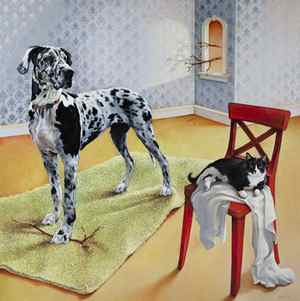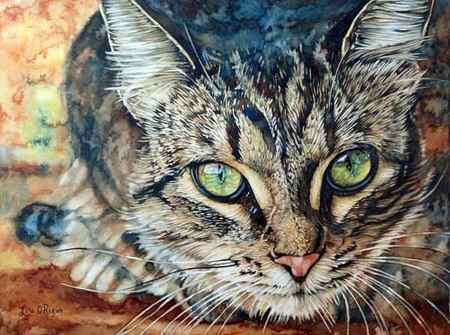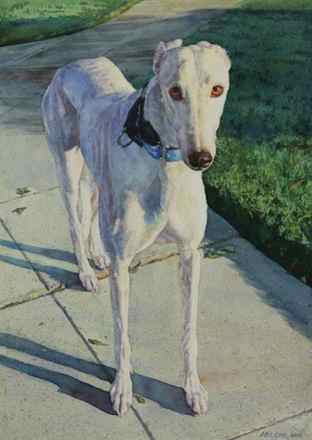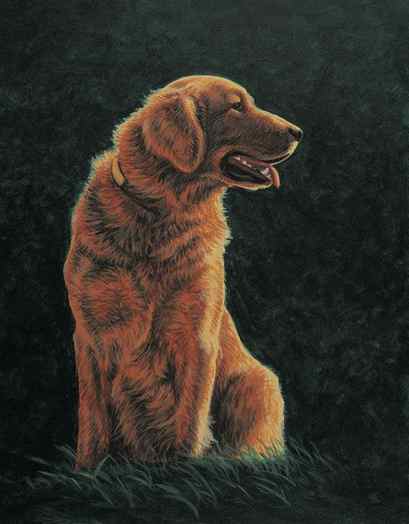I have had numerous commissions where the owner has sent me photographs in which the light is either flat, or worse taken indoors at night without exposure compensation, or direct lighting.
How to paint pet portraits
Join our Studio membership and save your favourite Painters Online content, from gallery artwork to step-by-step guides, to your own online mood boards. Create your go-to place for inspiration and learning. Plus, members can also enjoy a range of exciting features including monthly art videos and a digital magazine library.
If you are already a Studio member, simply login to your account.
Not a Studio member? Why not try our free 30-day trial – no commitment, no credit card required
How to paint pet portraits
Equipment
Colours
‘What better way of practising your art than creating a painting study of your pet,’ says Paul Talbot-Greaves.
‘Familiarity with your subject goes a long way towards success and you will already be familiar with your pet in terms of colour, size, type of fur and so on. You will also be familiar with their character, which will help to infuse any recognisable traits your pet may have. We are all different and animals are no exception – especially pets – from the shy temperament types to the disruptive ones, the cheeky biscuit thief to the ‘I’ll do anything for a bit of salmon’ personalities. When you know the character of an animal, you are more likely to capture that in a portrait or figure study.’

Charlie, acrylic on gessoed board (15x 15cm)
The day was fantastically sunny, which meant it was difficult to get the right shot of this white dog – one that did not reflect too much light and make him appear bleached out, although with too much contra jour he would lose shape and look too dark. So, I got him to turn slightly to catch some sunlight, which defined shape and form with reflected light from the ground.
For the painting, I began with darks of the eyes, nose, and mouth, then blocked in the blue greys, using ultramarine, ivory black and titanium white. In the light reflection under his chin I added yellow ochre, mixing it on the board before the paint had chance to dry.
I added slightly lighter blue greys then I applied the background colour to generate contrast.
At the end of the painting I brushed on thick titanium white to define the light shapes and to create the forms of the fur and whiskers
Design
So where do we begin?
Well as with any other painting subject, the picture should begin with good design.
Not every angle or lighting is going to be suitable, so take time to get this right. This article assumes you will be working from a photograph, although you might want to make studies from life, too.
The main problem here is that unless your pet is asleep or a slow-moving tortoise, they are not likely to keep still long enough for a painting session of any length.
At one time, I would make candid sketch studies of my cat, but the minute I pointed a camera at him, he would come to investigate the lens up close. I do not know why, but animals seem to take on a sense of mischief whenever I try to photograph them.
Special Sidekicks
I love my dog, Harper Lee. That is quite the understatement. I adore her. I talk to her, make her special dog-friendly treats, take her on special excursions, and invest in as much training as I can (with her strong-willed nature, she needs a lot). I’ll argue with anyone and everyone who thinks their pet is more beautiful and precious than Miss Harper is.

Chances are, if you have a special animal in your life, you feel the exact same way about them. The truth is that we’re all right. Each and every one of our beloved pets is more beautiful and precious than any other creature on this planet. It’s a strange law of nature, but it’s fact. How lovely would it be to capture just a fraction of your love and adoration for your furry friend by creating a pet portrait?

Whether you’re creating a pet portrait as a gift for a loved one or you’re creating one for your own home, you’ll want to bring all of that special animal’s endearing, quirky, and unique characteristics to artistic life. Here are some great places to find inspiration and get started.

Pet Portrait Inspiration
- Meet the Breeds…in Art
- Cat Art Past and Present
- Dog Paintings by Leslie Shiels, Sally Muir and Dana Hawk
- Cats in Charcoal | Yael Maimon Sketches and Paintings
- The Importance of a Good Photo Reference and What to Avoid

Draw Your Pets
- Demo: How to Draw Animals
- Demo: How to Draw This Tricky Part of a Dog
- How to Draw Cats in Pastel Pencil
- E-book: Step-by-Step Guide on How to Draw Animals
- How to Draw a Cat in Proportion
- Ready to Draw the Purrfect Cat? Colored Pencil Tips You’ll Love

7 Steps to Painting Beautiful Pet Portraits from Small, Partial, or Poorly Lit Photos

It’s very important to me as a pet portrait artist that everyone who commissions work comes away with a painting they feel is not only beautiful, but captures their pet perfectly.
The purpose of this article is to show how photos can be cut and arranged physically or digitally to become more than the sum of their parts. Starting from the very beginning, you can see what to expect when ordering a portrait. These are steps you should be able to take with any professional pet artist.
To avoid this step, follow my complete guide to taking pet portrait reference photos. But if that’s not possible…read on!
Use Mockups and Sketches to Start
One of the advantages of a painted portrait is that the artist can use creative licence to insert, remove, or improve elements captured by your camera.
A great pose with poor lighting can be combined with a well-lit (but otherwise uninteresting) photo to create something amazing! Some pet portraits even span many periods in the subject’s life.
For example, after I receive photos of a pet, I’ll start sketching out options.
These focus on the layout and composition. Then as a client, you can choose a pose and layout from the sketches, or request changes and refinements until we find something that’s just right.

Make a Collage of Reference Material
Once we’ve decided on the winning composition, I’ll sift through the available material and create arrangements to support it.
In the example below, my client wanted to use the sitting position from the photo on the left and her dog’s face from the photo in the middle. And for coloration, the photo on the right from when her lab was younger and more golden.
Of the three, only the centre photo was any higher resolution than you see here.

Using these images (and a couple others of her paws), I created the composite below.

You can see it’s not perfect, with the odd anatomy and mismatched lighting. But it’s enough to make sure I’m capturing both Tag’s unique posture and her features.
I used additional photos to refer to the get an understanding of her facial shape and expressions. For rendering, I used pet artist’s discretion and imagined a single overhead light source nearby.





